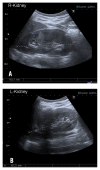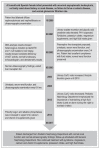Importance of Assessing Compliance with Conservative Treatment of Primary Hyperoxaluria Type 1: A Case Report of a Patient with I244T/c.969-3C>G Mutation
- PMID: 31905342
- PMCID: PMC6972639
- DOI: 10.7812/TPP/19.136
Importance of Assessing Compliance with Conservative Treatment of Primary Hyperoxaluria Type 1: A Case Report of a Patient with I244T/c.969-3C>G Mutation
Abstract
Introduction: Primary hyperoxaluria type 1 (PH1) is an autosomal recessive inherited disorder that progresses to end-stage renal disease. Patients experience excessive urinary oxalate excretion, which causes nephrocalcinosis and recurrent urolithiasis. When the glomerular filtration rate declines, calcium oxalate accumulates in extrarenal tissues, causing end-organ damage. More than 190 responsible mutations have been documented, with some genotype-phenotype differences reported. Regardless of the genetic basis, prompt diagnosis and treatment are decisive for the long-term outcome. If the condition advances to chronic kidney disease stage 4 or 5, a combined liver-kidney transplant should be considered.
Case presentation: We describe a 5-month-old asymptomatic female patient with bilateral diffuse nephrocalcinosis and nephrolithiasis. Laboratory and genetic findings confirmed PH1. She was promptly administered conservative treatment consisting of high fluid intake, calcium oxalate crystallization inhibitors, and pyridoxine. Nephrocalcinosis and urolithiasis disappeared after 2 years of treatment. As far as we know, this is a unique case of a patient with an I244T/null mutation diagnosed after the neonatal period and with normal renal function, who remained asymptomatic during an 18-year follow-up. This case is also unique because of the long-term therapeutic success.
Discussion: Physicians need a high level of suspicion to diagnose this rare disease. It has been previously demonstrated that early conservative treatment improves long-term outcomes, averting preemptive transplant during childhood. This case report emphasizes the importance of encouraging compliance with this approach, reinforces the need for good physician-patient communication, and raises awareness of the problems that might arise during conservative PH1 treatment.
Conflict of interest statement
The author(s) have no conflicts of interest to disclose.
Figures



References
Publication types
MeSH terms
Substances
Supplementary concepts
LinkOut - more resources
Full Text Sources
Research Materials

